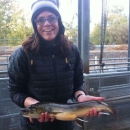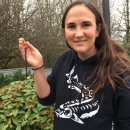Early detection and monitoring of aquatic invasive species invasive species
An invasive species is any plant or animal that has spread or been introduced into a new area where they are, or could, cause harm to the environment, economy, or human, animal, or plant health. Their unwelcome presence can destroy ecosystems and cost millions of dollars.
Learn more about invasive species (AIS) are vital in preventing their establishment and reducing their spread in aquatic habitats. The New Zealand mudsnail (NZMS), Potamopyrgus antipodarum, is an invasive aquatic snail that poses a threat to National Fish Hatcheries (NFHs). Conventional monitoring techniques may not reliably detect new infestations of NZMS due to the species’ small size and cryptic coloration. Environmental DNA (eDNA) is becoming an increasingly common tool for early detection of AIS, though few studies have quantitatively evaluated the efficacy of eDNA or other early detection techniques for NZMS. In this study, we performed paired eDNA sampling and visual surveys from 15 sites at five waterbodies with documented NZMS occupancy. We used a single-season occupancy model to estimate method-specific detection probabilities and probabilities of occupancy, if NZMS are not detected at an examined site. We also used a multiscale occupancy model to better understand small-scale spatial and temporal patterns in the probability of detecting NZMS by eDNA. A total of 43 visual surveys were conducted and 126 eDNA samples were collected from the 15 sites from 2015 to 2022. New Zealand mudsnail eDNA was detected at 13 sites in all five waterbodies, while visual surveys detected NZMS in five sites and in four of the waterbodies. The probability of detecting eDNA of NZMS was higher than the probability of detecting NZMS with visual surveys in both large (0.69 vs. 0.20) and small (0.94 vs. 0.74) systems. Expected probabilities of occupancy, if NZMS were not detected during sampling, were less than 0.05 when two samples of eDNA were collected in a small waterbody, three samples of eDNA were collected in a large waterbody, three visual surveys were conducted in a small waterbody, and when 14 visual surveys were conducted in a large waterbody. We observed small-scale spatial and temporal variation in eDNA detection in four of six sites where NZMS were detected, potentially due to low abundance, patchy distribution of NZMS or variable environmental conditions. This study adds to the growing body of work demonstrating the effectiveness of eDNA as an AIS early detection and monitoring tool in NFH and other aquatic habitats. Our results provide valuable insight into the nuances of each sampling technique and will help inform future AIS monitoring programs at NFHs.
Publication date
Type of document
Annual Report
Facility
Media Usage Rights/License
Public Domain
Program
FWS and DOI Region(s)




